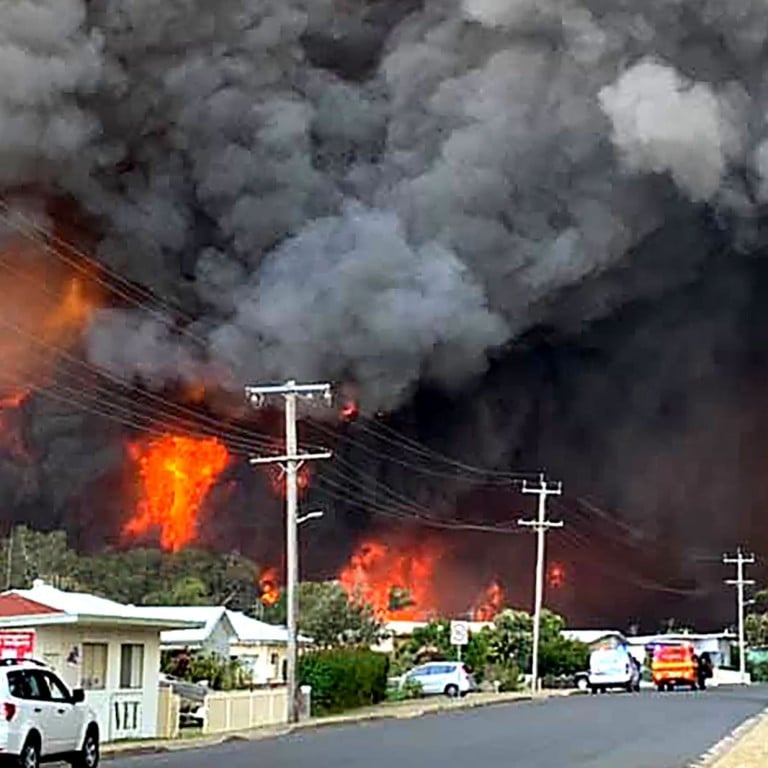
Bush fires tear through eastern Australia, leaving at least three dead and 150 homes razed
- At least seven people were unaccounted for in New South Wales state, and firefighters said the number of missing and dead could rise
- On Saturday morning, there were 72 bush fires still raging, including 18 out-of-control ones and six at emergency warning level, the fire service said
Firefighters located the remains of one man in a burnt-out vehicle near Glen Innes, some 550 kilometres north of Sydney, said Shane Fitzsimmons, the Commissioner of the New South Wales Rural Fire Service (RFS) on Saturday.
A woman was rescued by firefighters in the same blaze in an unrelated incident but later died in hospital, Fitzsimmons said on Saturday, adding that at least seven people remained unaccounted for and that the number of missing and dead could rise.
“We can’t rule out the really grave concerns that there could be more losses or indeed more fatalities as we get through and identify details across these fire grounds,” he told reporters in Sydney.
Around 1,500 firefighters were battling 70 fires across Australia’s most populous state, New South Wales, with the most intense in the northeast where flames were fanned by strong winds, Fitzsimmons said.
Some three dozen people, including 19 firefighters, were injured in the bush fires, the RFS said.
On Saturday morning, there were 72 bush fires still burning in the state, including 18 out-of-control ones and six at emergency warning level, the fire service said.
At the peak of the crisis on Friday night, a record 17 emergency level blazes were being fought by more than 1,000 firefighters, in what the RFS called “uncharted territory”.

Fitzsimmons said at least 100 homes had been destroyed, but the number was expected to rise as firefighters had not been unable to access some fire grounds to assess the damage.
“We are looking at least 100 homes [destroyed], although we still haven't got intelligence from a number of the fire grounds that we know have been impacted very dramatically,” he said, adding the number is likely to “climb as we get access to these areas”.
Prime Minister Scott Morrison said that if needed, the military could be called on to help some 1,300 firefighters who are tackling around 100 separate blazes.
“Sadly, we have lost two Australians and I fear that we will lose more before the day is out,” Morrison said as hundreds of civilians also volunteered to help their hard-hit neighbours.
New South Wales premier Gladys Berejiklian warned that next week’s weather forecast “could mean we’re not through the worst of it”.
The local jail at Glen Innes, which saw two fatalities, was forced to evacuate 164 inmates evacuated on Saturday morning due to bush fire risk to the prison, Grafton Corrective Services said.
Dry and windy conditions were forecast to continue, Fitzsimmons said.
The bush fires, which have already burned hundreds of thousands of hectares, were whipped up by gusty winds and temperatures over 35 degrees Celsius.
Bobin, a small town 330km north of Sydney, has been “destroyed”, according to locals who have shared photos on social media of burned out homes and school.
Roads have been closed in many areas, including parts of the Pacific Highway in eastern Australia, due to multiple bush fires.

In some areas, the bush fires have become so intense that they have created own weather system, including a lightning storm, the RFS said.
In Queensland, north of New South Wales, there were 36 out-of-control bush fires, including one at emergency level, according to Queensland Rural Fire Service (QRFS).
More than 2,000 people in Noosa were evacuated overnight and were sheltered at local showgrounds, sporting facilities and churches.
At least one home has been lost and one firefighter injured in Queensland, according to QRFS, but the figures were likely to rise.
Bush fires are common in Australia and a vast corps of firefighters had already been tackling sporadic blazes for months in the lead-up to the southern hemisphere summer.
But this was a dramatic start to what scientists predict will be a tough fire season ahead – with climate change and unfavourable weather cycles helping create a tinderbox of strong winds, low humidity and high temperatures.

Swathes of Australia have gone months without adequate rainfall, forcing farmers to truck in water at exorbitant cost, sell off livestock or leave their land to lay fallow.
Morrison, whose government has played down the threat of climate change sought to deflect questions about what impact it may have had.
“My only thoughts today are with those who have lost their lives and their families,” he said. “Australia has been battling ferocious fires for as long as Australia has been a nation, and well before. And we will continue to do so.”
Additional reporting by AP

.png?itok=arIb17P0)


